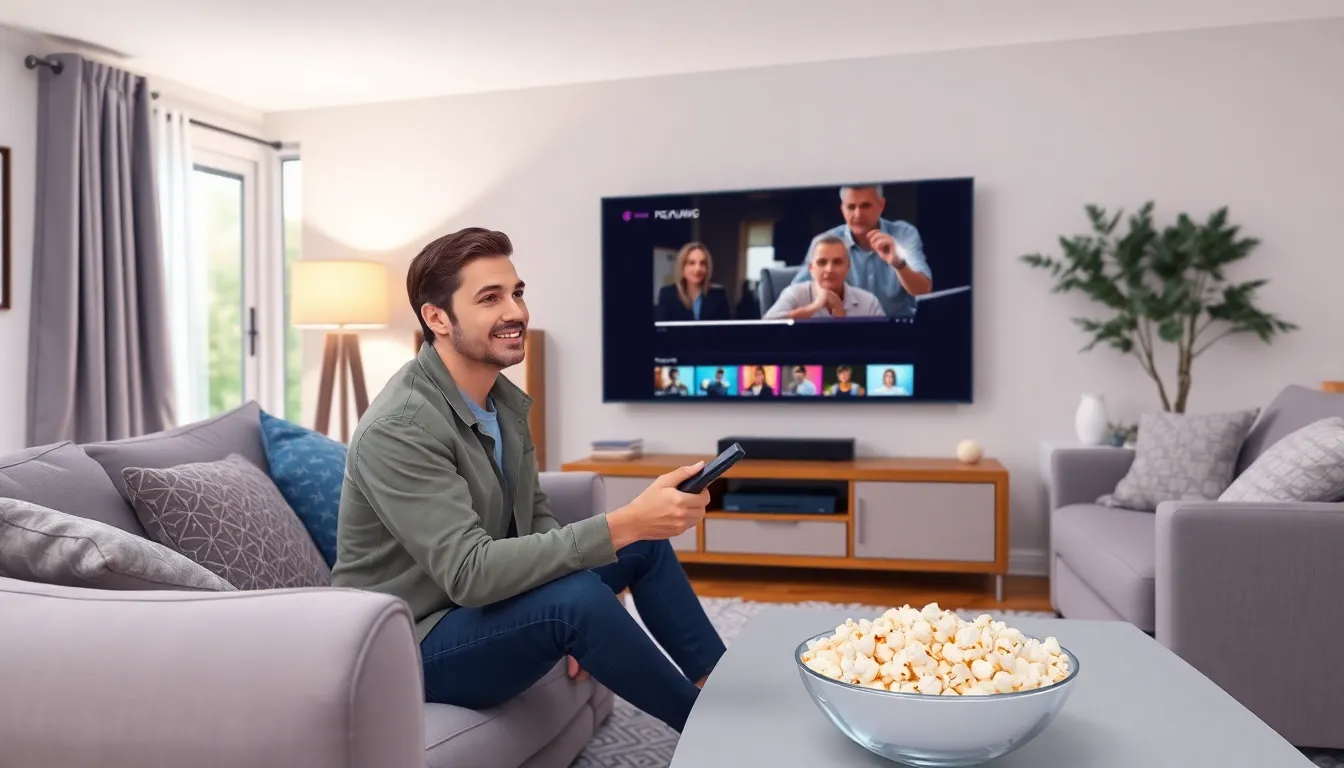Table of Contents
ToggleIn a world where binge-watching is practically an Olympic sport, knowing how to record streaming TV can feel like finding a unicorn. Whether it’s that nail-biting finale or a documentary that promises to change your life, sometimes you just can’t be glued to the couch. But fear not! With a few simple tricks up your sleeve, you can capture all the streaming magic for those moments when life gets in the way.
Understanding Streaming TV
Streaming TV allows viewers to watch shows and movies over the internet without relying on traditional cable services. This method provides flexibility in viewing times, enabling access to popular platforms like Netflix, Hulu, and Amazon Prime Video.
Content is typically available on-demand, meaning viewers can choose what to watch and when. Many streaming services offer original programming, giving audiences exclusive access to new series and films. Users can subscribe to various plans, usually with options for ad-supported or ad-free viewing experiences.
Quality of video can range from standard definition to 4K Ultra HD, enhancing the viewing experience. Internet connection speeds play a significant role, with higher speeds often leading to smoother streaming and less buffering. Popular streaming devices include smart TVs, streaming sticks, and gaming consoles, which contribute to seamless integration into home entertainment systems.
Different services come with varying libraries of content, affecting viewer choices. Some platforms also allow offline downloads, letting users watch shows and movies without needing an internet connection. Accessibility features, such as subtitles and audio descriptions, cater to a diverse audience.
Cloud DVR functionalities are now common in many services, permitting users to record live streaming content for later viewing. This advancement helps capture must-see moments, such as live events or series finales. Understanding these aspects of streaming TV creates a better awareness of the options available for recording favorite moments effectively.
Why Record Streaming TV?

Recording streaming TV presents several advantages for viewers. It allows individuals to catch up on missed episodes or rewatch favored series anytime. Convenience stands as a primary benefit, as viewers determine their own schedule without being tied to live broadcasts.
Benefits of Recording
Flexibility enhances the viewing experience. People can watch shows while enjoying meals or multitasking. Recording enables the ability to pause live events in case of interruptions. A significant aspect involves the option to store episodes for later enjoyment, enhancing binge-watching possibilities. Additionally, viewers can curate a personal library of favorite moments, ensuring access to cherished content whenever they want.
Legal Considerations
Legal implications of recording streaming TV warrant attention. Some services impose terms of use that limit recording capabilities. Copyright laws protect the content from unauthorized dissemination or sharing. Respecting intellectual property rights remains crucial in maintaining ethical viewing practices. Consumers should remain aware of platform-specific restrictions, as these may affect recording functionalities. Recognizing these regulations helps viewers make informed decisions regarding their recording options.
Methods to Record Streaming TV
Viewers enjoy various methods to record streaming TV shows and movies. Understanding these options provides flexibility in capturing content for later viewing.
Using Built-In Features
Many streaming services include built-in features for recording shows. For instance, platforms like Hulu and YouTube TV offer cloud DVRs, allowing users to record live broadcasts easily. These features often come with specific storage limits, usually ranging from 50 to 200 hours of content. Recordings typically last for a set period, often 9 months to 1 year, after which they may expire. Users can access recorded content from any compatible device linked to their account, ensuring convenience and accessibility.
Third-Party Software
Third-party software provides additional options for recording streaming TV. Programs such as OBS Studio and TubeCatch allow users to capture streaming content directly from their screens. Compatibility with various operating systems makes these tools versatile. Recording quality often depends on the user’s settings and hardware capabilities, with options for different resolutions. Users should ensure compliance with copyright terms when using these programs to avoid legal issues.
External Devices
External devices, like DVRs or capture cards, offer reliable alternatives for recording streaming TV. Dedicated DVRs, such as TiVo or the Amazon Fire TV Recast, facilitate recording from streaming services directly. Capture cards, often used by gamers, can also record video from streaming apps. Devices usually connect via HDMI, ensuring a clear picture and sound quality. Once recorded, content becomes accessible for playback on multiple devices, enhancing user experience.
Tips for Successful Recording
Effective recording of streaming TV requires strategic planning. Apply these tips to enhance your recording experience.
Optimizing Storage Space
Maximize available storage by selecting quality settings that suit personal needs. Cloud DVR options typically allocate limited storage, so prioritize recording crucial shows. Regularly delete unwanted recordings to free up space. Consider purchasing additional cloud storage from your service provider if available. External hard drives can also extend storage capacity for standalone DVRs. Evaluate the storage limits before starting a recording to avoid interruptions. Organizing recorded content into folders helps locate shows quickly. Keeping track of the most important recordings ensures a smooth viewing experience.
Scheduling Recordings
Schedule recordings to capture live broadcasts effortlessly. Many streaming services allow users to set reminders for upcoming shows. Access the service’s interface to find the scheduling feature, which often includes options for recurring episodes. Vary the recording start and end times to avoid missing content due to delays. Some platforms offer the flexibility to record entire series, ensuring every episode is captured. Checking the scheduled recordings list helps track current and upcoming reminders. Regularly update schedules when shows change time slots for accurate recordings.
Recording streaming TV offers viewers the freedom to enjoy their favorite shows and movies at their convenience. By understanding the various methods available, from built-in cloud DVRs to third-party software and external devices, users can easily capture must-see moments.
Strategic planning plays a crucial role in successful recording. By optimizing storage and scheduling recordings, viewers can ensure they never miss an episode. Staying informed about legal considerations and platform-specific restrictions helps maintain compliance while enjoying the flexibility of on-demand content.
With the right tools and techniques, anyone can build a personal library of memorable streaming moments.







